Italian Culture - Art
Part 2 - Early Christian & Medieval Art
Early Christian Art
Early Christian art spans from the beginnings of Christianity until about the early 6th century, particularly in Italy and in the western Mediterranean. In 313 the Edict Of Milan issued by the Emperor Constantine the Great gave Christianity legal status; imperial sponsorship brought the religion popularity, riches, and converts from all classes of society. In 380 Emperor Theodosius I made Christianity the state religion of the Roman Empire; as a consequence, art and architecture flourished and developed on a vast, ambitious scale.
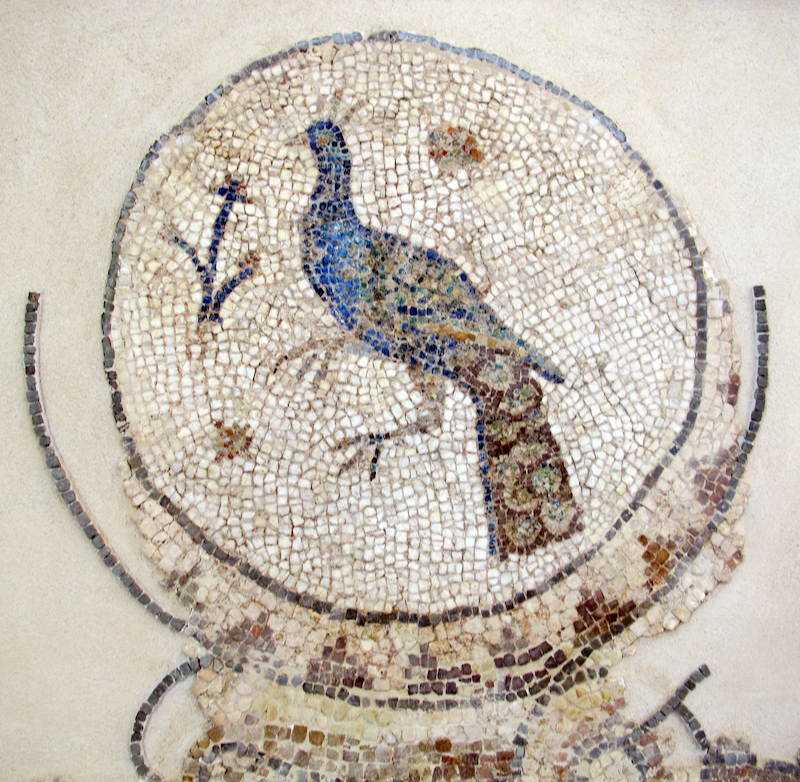
Early Christian mosaic with peacock.
The earliest Christian art dates back to the 2nd century: wall paintings in the Roman catacombs (underground cemeteries consisting of galleries with recesses for tombs). At the beginning its iconography was mainly symbolic, but in the following centuries Christian art incorporated pagan prototypes that were familiar to the Romans. That’s why in the earliest representations Christ is symbolised by a fish, and later is depicted in the guise of familiar gods or heroes, namely Apollo. Other symbols in early Christian art include the Dove, representing the soul, or the Holy Spirit; the Peacock, a symbol for eternal life; the Good Shepherd as Christ, who guides and protect the faithful; the Grapes, representing the blood of Christ; the Eagle, a symbol of the purification obtained through baptism.
Visit: The Christian Catacombs of Rome
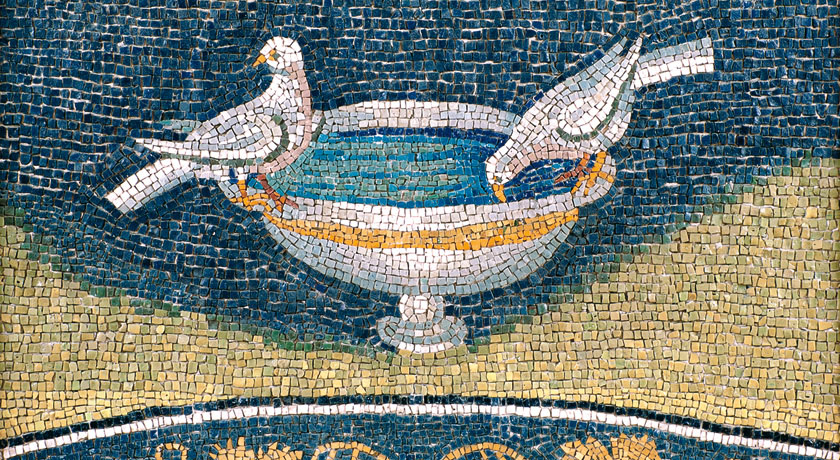
Mosaic, mausoleum of Galla Placidia, Ravenna
Why the fish as a symbol of Christ?
The Greek word for fish is ichthùs; its letters correspond to the initial letters of the Greek sentence: Iesoùs Christòs Theoù Uiòs Sotèr (Jesus Christ Son of God Saviour)
Churches and shrines soon spread throughout the empire. They developed from the architectural structure of the Roman basilica, originally a public building with a rectangular plan, a central nave flanked by two or more aisles, and a roof at two levels. The walls of churches were decorated with paintings and mosaics to instruct the faithful. The church of Santa Maria Maggiore in Rome has mosaic scenes depicting episodes from the Old and New Testament dating back to 432; another stunning example of mosaics can be found in the mausoleum of Galla Placidia (daughter of Theodosius I), built 425-450, in Ravenna. Sculpture flourished as well: a marvellous example of relief sculpture can be found in the sarcophagus of Junius Bassus (died 359) which clearly reflects the new status of Christianity: before the Edict of Milan, the figure of Christ was rarely represented directly, while here Christ is given a prominent position in the centre of the upper register.
Visit: Ravenna, Mausoleo di Galla Placidia
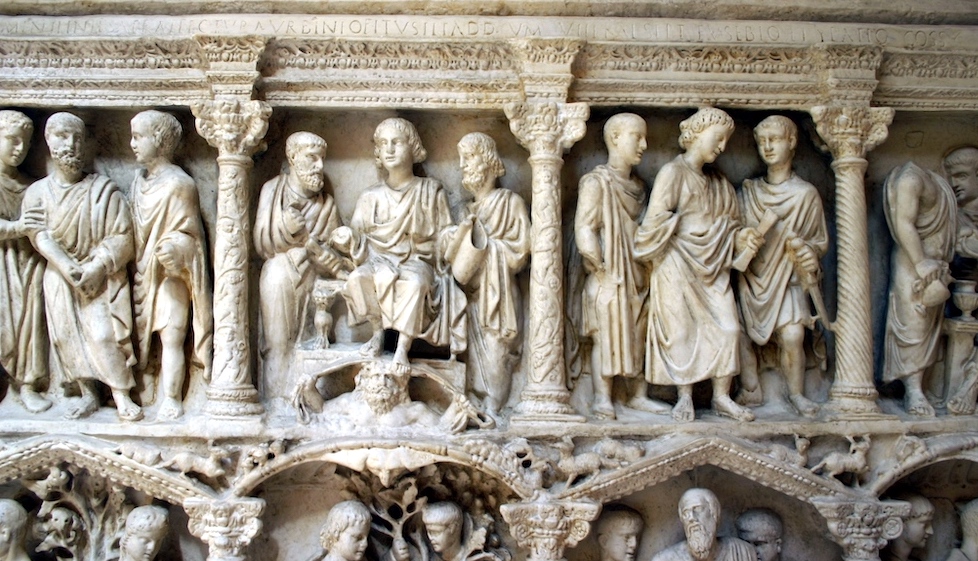
Sarcophagus of Junius Bassus, Museo del Tesoro di San Pietro, Vaticano
Italian Romanesque Art
Romanesque art is the first international style in Europe since the fall of the Roman Empire, developing along an arch that went from Spain to Poland, including Italy to the South and Great Britain and Scandinavia to the North. Ideas spread thanks to pilgrimage routes to shrines such as Santiago de Compostela, and as a consequence of the crusades. Ideas then developed and changed, merging into local traditions, thus giving birth to regional variants: that’s why Tuscan Romanesque differs from the one produced in northern Italy (not to mention Northern Europe).
When Charlemagne was crowned Holy Roman Emperor in 800, the remains of the Roman civilisation were all over the continent, and legends of the great empire were still being passed down through generations. To unite his empire and validate his reign, his architects began building churches in the style of Early Christian Rome, with a clear reference to Constantine, the first Christian Emperor. With the newly regained political stability society underwent deep changes; at the same time, the great expansion of monasticism in the 10th and 11th centuries brought to the flourishing of churches all over Western Europe: therefore the most representative feature of Romanesque art are churches, and the treasures that adorn them. The architects looked to Christian Roman edifices as a model, and the new style began to be used in gatehouses, chapels, and churches. Semi-circular arches, thick wall, arcades, vaulted roofs and towers were its main characteristics.
Since it is impossible to discuss the incredible richness and variety of Italian Romanesque, our goal is to present the reader with a few examples of those unique achievements reached in Italy from the second half of the 11th century throughout the 12th.
Examples of Northern, Central and Southern Romanesque styles

Relief by Wiligelmo, Duomo di Modena.
One of the most significant structures of Northern Romanesque architecture is the Cathedral of Modena. The building site, which dates back to 1099, was entrusted to the architect Lanfranco. The layout of the church is similar to that of a basilica, with three naves, without a protruding transept, while the salient facade shows the internal link between the central nave and the lateral naves. On the structure created by Lanfranco are carved, with extraordinary harmony, the sculptures of Wiligelmo, splendid decorations of vegetation motifs and fantastic beings. His expertise is evident in the reliefs of the Genesis and in the decoration of the main portal. His admiration for antiquity is shown in the large capitals adorned with leaves on the internal columns of the central nave. From 1190, craftsmen from Campione (now Switzerland) brought with them artistic trends from France: their masterpieces are the presbytery area and the rosette on the facade of the Royal Door, the monumental entrance on Piazza Grande. Attributed to them is the decision to build the tower, the famous Ghirlandina.
Tuscan Romanesque: In Florence, sorely tried by Barbarian invasions, cultural life flourished again in the 10th century. The idea of a rebirth of antiquity is so deeply rooted that Tuscan Romanesque is intensely classic. San Miniato al Monte (11th - 12th Century) is one of the masterpieces of Tuscan Romanesque. By 1018, the bishop of Florence had ordered the construction of a church and installed a community of Benedictine monks on the crest of a hill (monte), following a medieval pattern of locating monasteries just outside the city walls.
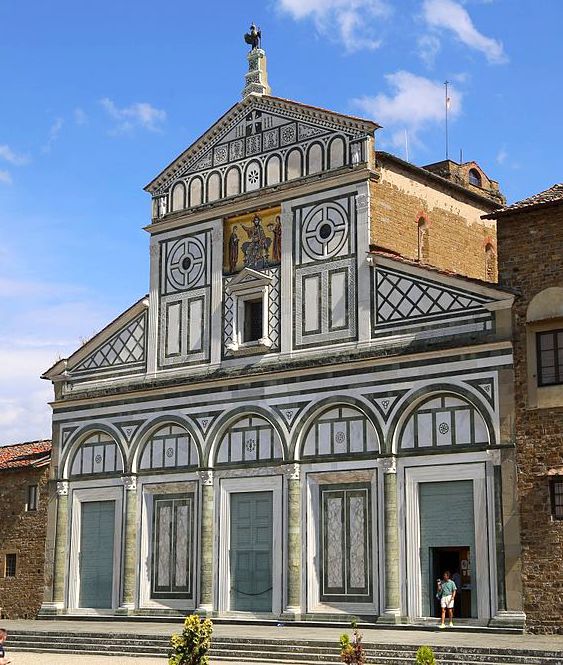
San Miniato al Monte, Florence.
(Photo by Rufus46, CC BY-SA 3.0)
The church combines a basilical plan of classical origin with typically romanesque elements. An arcade of polished stone columns supporting Corinthian capitals flanks the nave, above which colourful stone inlay brightens the surface, a reminiscence of Early Christian basilicas. This style of construction, joining modified basilical architecture with colourful, two-dimensional stone inlay, would become typical of the Florentine region. Many of the capitals are Roman spolia, noticeable because they are much narrower than the columns they crown. The oldest decorations are the mosaics and the marble inlay work in the pavement, showing interesting figurative motifs enriched with symbolic significance. Here the beautiful Zodiac, originally a pagan motif, acquires a Christian symbolic value, where the twelve signs allude to the twelve Apostles. The apse is dominated by a mosaic depicting Christ between the Virgin, St. Miniatus, the symbols of the Evangelists and the kneeling donor.
Visit: Florence, San Miniato al Monte
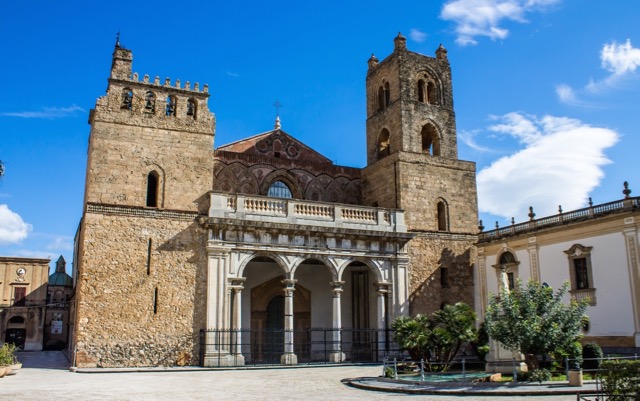
Duomo di Monreale, Palermo.
The Romanesque style of Southern Italy owes much to the Normans, who conquered Sicily in 1091. A stunning example of how different cultural elements merged is majestically represented by the Cathedral of Monreale, one of the greatest productions of Norman Romanesque architecture, renowned for its stunning mosaics and its incredible fusion of Arab, Byzantine and Romanesque features. The facade is flanked by two towers and a portico; the two stunning Romanesque bronze doors sculpted by Bonanno da Pisa are adorned with 42 reliefs of biblical scenes; the doorways and their pointed arches are magnificently enriched with carving and coloured inlay, a curious combination of three styles - Norman-French, Byzantine, and Arab.
The interior is notable for its mosaic decoration, one of the largest in existence. It was created in less than 10 years by a group of craftsmen trained in Byzantium. The subjects of the mosaics include an Old Testament cycle, the miracles of Christ, the life of Christ, and the lives of Saints Peter and Paul.
Italian Gothic art
The Gothic was the natural development of the Romanesque architectural style, when prosperity and relative peace brought centuries of cultural progress and great building projects. From roughly 1000 to 1400, several significant cathedrals and churches were built, particularly in Britain and France, offering architects and masons a chance to work out more complex designs. France was the centre of gothic culture, but it soon spread throughout Europe, giving birth to local styles with their own peculiar characteristics. It was in the Renaissance that the name Gothic was applied to this medieval style that appeared vulgar to Renaissance sensibilities.
The fundamental element of the Gothic architectural style is the pointed arch, likely borrowed from Islamic architecture, which had spread through Spain. The pointed arch allowed to reduce the size of the supporting columns, which could be more slender. Registers of columns were repeated in the upper levels of the nave, becoming almost part of the vault. The ribbed vaulting is another distinguishing feature of Gothic architecture that sprang out from late-Romanesque buildings. The slender columns and lighter systems of thrust allowed for larger windows and more light, and love for details and decoration increased significantly. In late Gothic buildings almost every surface is decorated.
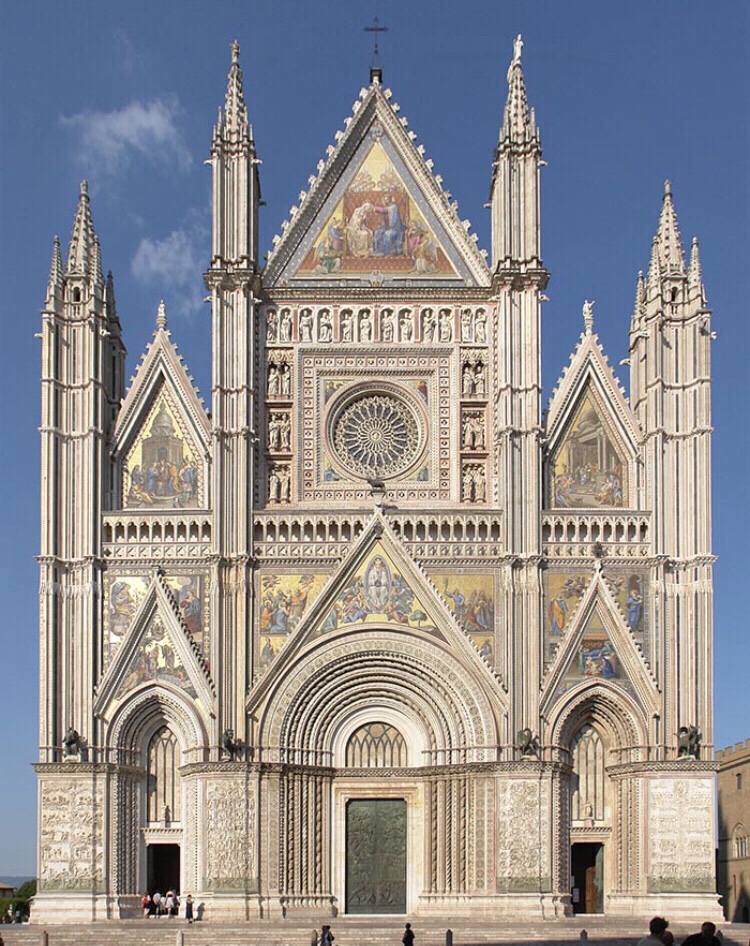
Duomo di Orvieto.
The list of architectural masterpieces is endless, and goes beyond the purposes of this page: we’ll mention the gothic Cathedral of Orvieto, one of the most celebrated. The cathedral was begun in 1290; its west facade, a fine polychrome monument of richly sculptured marble, is divided into three gables with intervening pinnacles. The interior of the building is richly decorated with the work of a number of sculptors and painters, notably the frescoes by Luca Signorelli and Beato Angelico in the Cappella Nuova. Many 16th-century sculptures adorn the cathedral, which was completed in 1580.
The 13th century saw the consolidation of the communes’ independence and power, hence the development of buildings that served as the seat of the local, independent government. The Palazzo Pubblico (town hall) in Siena, begun in 1297, is an example of Italian Gothic architecture: the lower story is stone while the upper crenellated stories are made of brick. The facade of the palace is curved slightly inwards to reflect the outwards curve of Piazza del Campo, Siena's central square, of which the Palace is the focal point.
Gothic painting
In the 13th century both Rome and Tuscany had flourishing pictorial traditions: strongly influenced by Byzantine art, they soon developed a more realistic style where the stiff, frontal, golden Byzantine archetypes were abandoned in favour of a more natural rendering of volumes and colours. One of the most notable examples of this evolution towards increased realism is in Assisi, where the upper church of San Francesco was decorated by Roman fresco painters around 1280-1300. In Tuscany the stylistic changes are probably best revealed by the "Maestà” of Duccio di Buoninsegna (1308–11), formerly the high altarpiece of Siena cathedral.
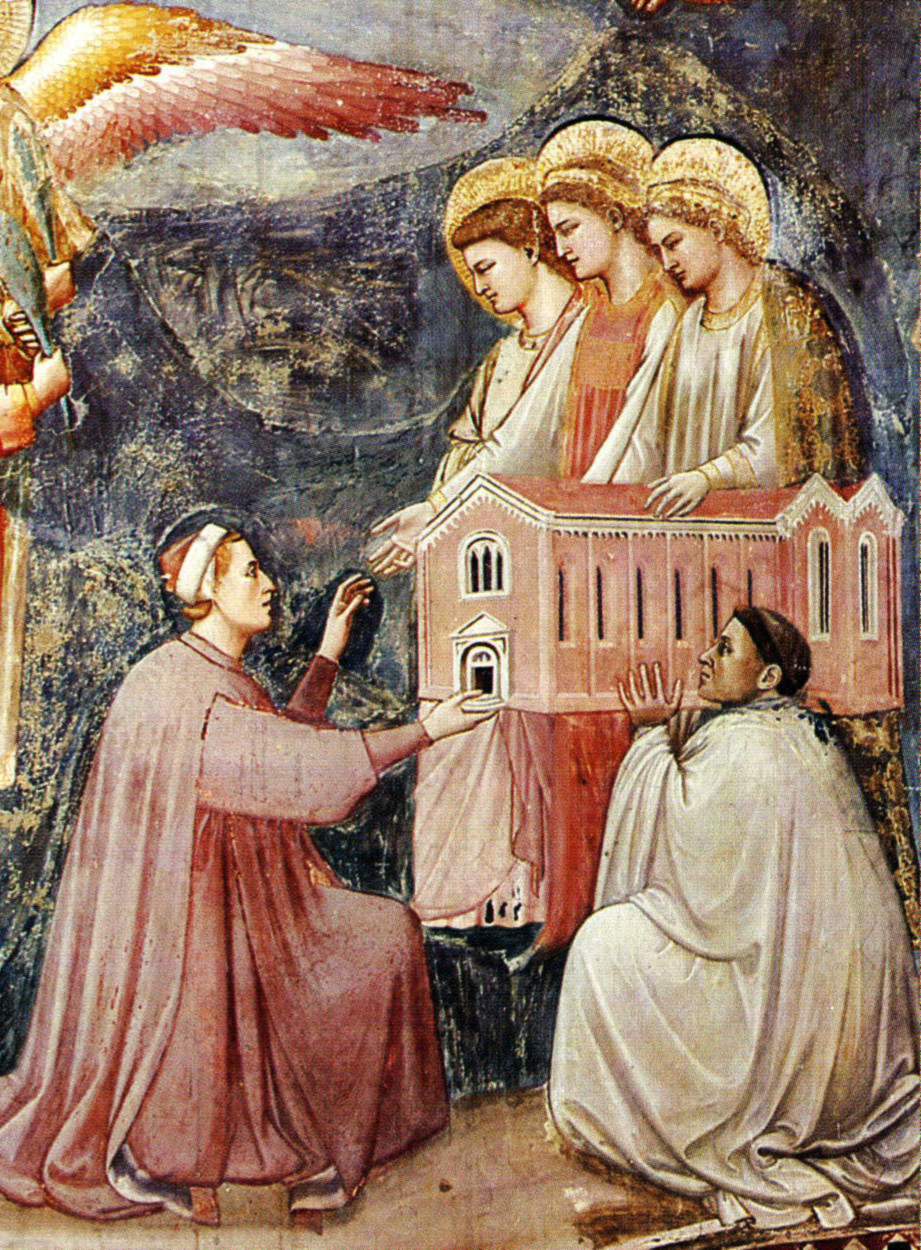
Cappella degli Scrovegni, Padua.
The use of light and the first attempts in the use of perspective (whose rules at the time had not been developed yet) brought to a greater narrative power, where figures are placed in a more human space, as opposed to the divine space of Byzantine art. Cimabue, Ambrogio Lorenzetti, Duccio da Buoninsegna, Luca Signorelli, Beato Angelico are just a few outstanding names that belonged to this rich and innovative tradition; its climax is evident in the amazing work of Giotto di Bondone (c. 1267 - 1337). Trained in Rome, Giotto executed his first important surviving work for the Pope Enrico Scrovegni at the latter’s family palace in Padua. The frescoes are a unique masterpiece in which all the lessons of Roman mural painting were translated into a narrative sequence of great modernity and expressiveness.
Gothic sculpture

Giovanni Pisano, Battistero di Pisa.
Gothic sculpture followed the path opened by Romanesque art towards a more natural rendering of the human body; sculptures were no longer a part of the decoration of an architectural ornament, but started to emerge as independent elements. Benedetto Antelami, Arnolfo di Cambio, Andrea Pisano, Nicola Pisano, and Giovanni Pisano are outstanding sculptors. Nicola Pisano (1220–84), sculptor and architect, and his son Giovanni (1240-1315) developed a style that is often called Proto-Renaissance, where the influence of Roman sarcophagi is evident. Some of their masterpieces are the Pulpit of the Baptistery of San Giovanni in Pisa, the Fontana Maggiore in Perugia and the pulpit in the Pieve of Sant’Andrea, Pistoia. A masterwork by Giovanni is the pulpit in the Cathedral of Pisa.
Part 1: Ancient Art Part 3: The Renaissance

Our book & video course Learn Italian with Art is now available on Amazon and Apple Books.
Basic Glossary
affresco - Fresco; a technique of mural painting executed upon wet lime plaster.
basilica - Originally a Roman public court building; later, Christian buildings of the same shape, with a central nave and aisles.
bassorilievo - Low relief; a projecting image with a shallow depth.
cattedrale - Cathedral; the central church of a diocese that contains the bishop's seat, cattedra (Latin cathedra).
cupola - Dome; an architectural element that resembles the hollow upper half of a sphere.
duomo - Current or former cathedral.
facciata - Facade; the front side of a building. Usually the facade of a church or palace.
mosaico - Mosaic; an image built up from small pieces of stone, glass or ceramic.
olio su tela - Oil painting on canvas.
pala d'altare - A religious painting placed behind the altar in a church.
villa - Originally a Roman upper-class country house.
Further readings
For more in-depth information about this topic, we recommend:
Diana E.E. Kleiner, Roman Architecture: A Visual Guide (2014)
Kenneth Bartlett, The Renaissance in Italy: A History (2019)
Michael Wyatt, The Cambridge Companion to the Italian Renaissance (2014)
Walter Isaacson, Leonardo Da Vinci (2017)
At no additional cost to you, we will earn a commission if you make a purchase on Amazon after clicking through the links listed above. This will help support this Website.
